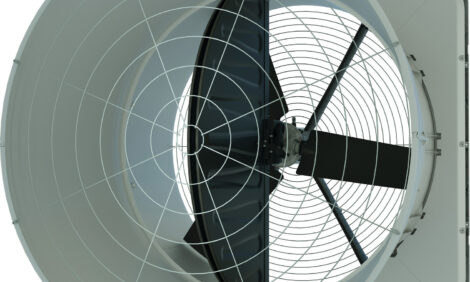



Breeding for Adaptability: a Priority Research Area
The performance of any individual depends on its genetic makeup and the environment in which it lives. The environment is defined as everything other than genetic. The superiority of a bird is no more judged in terms of one character, but by the overall profitability, writes Dr T. Kotiah from Indbro Research & Breeding Farms Pvt Ltd.In layers, it is a combination of number of eggs, the size, feed consumption and the flock depletion. The broiler bird is judged not only by weight gain, but also by feed efficiency and depletion. An integrated broiler producer even considers the breeder performance above and yield characteristics below.
Commercial chicks are Hybrids produced by crossing closed populations with known hybrid vigor. The selective breeding with in the line is undertaken by the multinational companies under strict biosecurity. The business is very competitive and the companies target the improvement of performance to maintain the market share. These improvements may not continue in the same direction due to 1. Approaching the genetics limits in improvement. The geneticists argue that that the genetic variability is not exhausting. 2. Genotype and environmental interactions. A Superior bird in moderate climate becomes inferior to its counterpart in hot climates. 3. Emerging new situations. Environment laws like “No molting” have changed the goals of layer selections to persistent laying and better shell quality after 72 weeks of age. When the market changes to heavier birds, the bone strength shopuld be increased by direct selection.
Current production levels & goals of improvement
Let us look at the expected changes that could take place by 2020 and beyond, if the current breeding policy continues. The expected performance levels are projected below.
| Broilers | 2010 | 2020 | 2030 |
|---|---|---|---|
| Days at slaughter | 40 | 30 | 20? |
| FCR | 1.7 | 1.5 | 1.3? |
| Mortality | 2.0% | 1.0% | 0.5%? |
| Breast meat | 30% | 33% | 36% |
| Layers | 2010 | 2020 | 2030 |
| Eggs to 72wks | 320 | 340 | 360? |
| Average Egg weight | 59 gms | 60 gms | 51 gms? |
| Egg Mass | 18.8 Kg | 20.4 g | 22.0? |
Some of the above goals look like unachievable or need changes under other considerations.
The non genetic or the Environmental factors are-
- Housing provided & the climate that is mainly the out side temperature.
- Quality of feed and
- Microbial challenge
Housing Environment – Most of the poultry breeding work has been carried out done in advanced countries over last 100 years. The houses are closed and the environment of the house is regulated. These poultry breeding companies are responsible for development of poultry industry in the developing countries and hence, besides supplying the stocks, they advise on the environment to be created to achieve the best performance. When one breed gets seeded in one market, the industry standards in that country automatically get set to those norms. Even if another bird enters that market, its capability is judged on the same lines.
The economy of every country is different. Building the poultry houses to control the environment is an expensive proposition. In hot climates, the house temperatures are controlled by evaporative cooling of closed houses. These houses are expensive to build and the running cost is heavy. The energy is expensive. Many of the countries have to import the whole poultry house.
Countries like India have tried open sided houses with traditional methods like natural airflow, fogging etc. The housing cost per bird is a lot less. Production may be less in very hot climates. But when the depreciation on expensive houses and the running costs are calculated, it has been found meaningful to continue with open houses. The economics are compared in the following table.
| Capital Costs - Broiler House | ||
|---|---|---|
| Variable | Conven. House | EC House |
| Area in sq. ft. | 20000 | 20000 |
| No of birds per batch | 20000 | 40000 |
| Cost of the house(INR) | 20.00 lacs | 20.00 lacs |
| Cost of upgrading(30%) | 0.0 | 6.00 |
| Cost of feeders | 0.80 | 12.00 |
| Cost of waterers | 0.80 | 6.40 |
| Cost of fans (8 nos) | 0.0 | 2.00 |
| Cost of pads | 0.0 | 4.00 |
| Cost of curtains | 0.28 | 2.00 |
| Cost of gas brooders | 0.80 | 1.60 |
| Cost of chick feeding & watering | 0.48 | - |
| Power Generator | 0.0 | 4.00 |
| Electronic supervisor | 0.0 | 3.00 |
| Total (INR in Lakhs) | 23.48 | 61.00 |
| (Note - One lakh is 100,000) | ||
To offset the three times high capital cost, the number of birds per house has to be increased from 20,000 to 40,000. Increase in density demands additional care and investments on mechanical feeding etc.
Quality of feed & price - To exploit the genetic capability of the bird, improvements are made in the feed.
Some of them, done during last decade are as follows.
Energy levels in broiler feed enhanced from 2800K.Cal/Kg feed to 3300.
Lysine in broiler feed 0.8 to 1.3 per cent
Methionine level in feed enhanced from 0.35 to 0.50 per cent
Vitamin A 8000 to 16000IU per Kg.
Vitamin D3 from 1600 to 3500IU per Kg.
Aflatoxin levels of feed being monitored and maintained below 10PPB.
The availability and quality of traditional feed ingredients is fast changing all over the world. Diversion of Maize to Ethanol production has reduced the availability of the key ingredient (60-65 per cent of the feed) and increased the prices. The price of Soya and other ingredients is going up through the demand of enhanced poultry production through out the world. If the trend continues, only the second grade grain will be available for poultry. Hence, the feed materials with lower nutrient levels and with higher toxin levels have to be accepted by the poultry industry.
The above factors are increasing the cost of inputs and ultimately the production cost. The risk of poultry keeping is on the increase.
Disease situation - There are poultry diseases, which are vertically transmitted. These diseases can be successfully eliminated by the breeders. They also keep watch on the emerging problems. Vaccines are invented against many known Viral Diseases. Although the number of vaccines and the cost of vaccination has gone up, the problems are preventable. There are bacterial problems like E.Coli and Mycoplasma, which are present everywhere. They are carried by the care takers. The high performing birds born in sterile environment are also unable to take these bacterial infections. A little change in day temperatures and less care in management will make the whole flock suffer. The problems are compounded in highly dense houses and larger flocks are at greater financial risk. These infections can be treated by using antibiotics. But, the consumer awareness about the transmissible resistance to antibiotics is magnifying the dangers of usage and the use is being prohibited every where.
“All In All Out” system of poultry housing and biosecurity protocols to reduce the general infections of Mycoplasma and E.Coli are all adding to the cost of production.
The food safety regulations and environmental issues may limit the use of some housing systems and restrict the use of high performing feed formulations with safety ingredients in feed. This, also ultimately will add up to the production cost.
Breeding for Adaptability
Instead of getting a bird bred in moderate climates and providing the environment that suits the bird, can we breed the birds under a particular set of acceptable environment systems? Will the adaptability be built in as a genetic trait, which will make the bird tolerate some of the above environment situations?
With advanced genetics knowledge, one way could be to produce genetically modified varieties. Although the poultry genome is totally mapped, the techniques are not yet proven. There is a hue and cry about genetically modified vegetables and crops in many countries. Will the gene replacement or gene introgression be accepted in food animals or treated as GM (Genetic Modification)?
Hence, breeding the birds in environments under which they have to live, seems to be the logical solution. The breeding techniques to achieve this could be:
- Breed the birds under the climate where it should perform.
- Breed the birds in suboptimal conditions, so that they will perform well when better environment is provided. Exposing the breeding stocks to sub-optimal conditions is not recommended, for the reasons that we may loose the stocks or the problems might be carried over to generations vertically. One set of pedigreed stocks is exposed to suboptimal climates and the pedigree data can be used to select the stocks of the same pedigree stocks elsewhere.
- The third alternative could be to identify the genes, which can make the individual better adaptable. Fixing the specific genes in populations can lead to improvement in the adaptability.
Out of the above, breeding under the practical conditions, where we need the birds to perform with proper biosecurity to protect the birds from vertically transmitted problems is the sure way of achieving adaptability.
Indian Poultry Industry
Indian poultry farming has been unique in many ways. The farming methods of the western countries are not copied. The present day “open sided” huge layer houses with capacities up to 50,000 birds per house have evolved over a period of time by trial and error. The feed formulations are based on the locally available ingredients with “least cost” formulations. The laying farms are multi age groups with three or four replacements per year. Separate all in all out rearing facilities for growing the replacements keeps all facilities utilized at optimum level. The experiments with low investment houses and least cost feed formulations using unconventional feed ingredients have helped in production of eggs at prices lowest in the world.
The broiler farms do not exeed a capacity of 50,000 birds and the houses are open sided and less expensive. The batches are reared on “All in All out” basis. The broiler feed is also less dense compared to the other parts of the world.
The main advantage with Indian bred birds, the farmer talks about is “Adaptability” of the birds. The farmer’s concerns are: If the flock gets in to toxicity, How fast the flock recovers? How much drop in production will be there when the temperature crosses 40°C? Will the flock come back fast if the temperature is reduced? How well the bird can take least cost feed, which has low energy & high fiber. Mycoplasma and E.Coli can surface with change in climates. How well the flock takes the infections? How fast the flock recovers after the treatment and to what level of earlier production the flock would reach?
| Parameter | Indian Bred | Imported |
|---|---|---|
| Eggs: Av. Feed Good Feed |
300 310 |
285 305 |
| Produc Drop in High Temp. | 5 - 10% | 20 - 30% |
| Recovery | 10 days | 30 days |
| Feed Toxicity | Moderate | Severe |
| Recovery | Fast | Slow |
| MG & E.Coli | Mild | Serious |
| Recovery After Medication | Fast | Slow |
The broiler industry also has the similar concerns. Will the broilers survive and grow in summer months? There are certain months in an year where the broiler prices are bound to be low (due to festivals, where certain communities abstain from eating meat). These are “Sure to Lose” months in the live bird market. The birds cannot be frozen and stored for long duration due to non-acceptance of stored chicken and lack of cold chain. The broiler producer wants to invest less by low cost feed and lose less. Will the birds give optimum performance with the low dense feed? The chick production cannot be stopped by integrators.
Poultry Breeding in India
Indian poultry industry has decided to be self sufficient in breeding stocks also about 40 years ago and went in for pure line breeding since 1970s. Most of the poultry breeders and many poultry technicians in India were skeptical. They asked. can we do this?
The industry and the Government has kept an "open attitude".
The import of the outside brands are allowed in to the country and there are no special protections or incentives to Indian breeders.
It has been interesting to watch the breeding business in India. Over 80 per cent of the poultry farms in the country house Indian bred layers in spite of the continued imports of the leading brands and are available at the same price. A total of 65 per cent of the broilers produced are bred in India. 95 per cent of the rest of 35 per cent are reared by Integrators providing high dense feed and better health care. Only five per cent of the day old broiler chicks sold to the farmer are from imported origin. The broiler industry also produces the results comparable to any other developed country in terms of growth, feed efficiency and mortality with birds bred in India.
The requirements of a successful breeding programme are: Breeding Stocks, Facilities & Manpower, Breeding Technique, Money and a bit of Luck.
The breeding stocks are to be built up and getting the pure lines with a known combination by the established breeders and setting up a breeding facility on the same way the industry works is the best proposition. The pure line birds may not behave in the same way and take two or three generations to get back to acceptable level of performance. It will be like a new set of genes coming in to play in a different environment and building up the desired constitution will take time. Development of a system by synthesising the lines is possible but takes much longer time and money. Investment on Infrastructure is relatively low in countries like India, where the basic raw material is locally available.
Individual data collection on large number of birds, which is the main job in poultry breeding is manual and it is less expensive in India. India has the technology, technical and non technical man power with reasonable wages. The Money can be raised to start with.
The Results
Poultry breeding in India is successful. The advantages are that the birds adapt to the climate fluctuations, accept average feed and bounce back into production after a problem using lower quality feed, experiencing high temperatures and meeting disease challenges to reach a profitable the end to the cycle. The broiler bird has a short life of 40 days and under. Typical genotype environment interaction can be seen in the broiler performance. The difference in performance of broilers is more perceivable in a short time.
The results of such a situation are typically presented below.
- The market share of Indian bred birds is more than imported birds.
- The Broiler Random sample tests conducted by Government. Results of a test where both have participated are given below (RST, Gurgaon 2006). More data is not available due to lack of participation.
| Imported | Indian Bred | |
|---|---|---|
| Chick weight | 44 gms | 42 gms |
| Weight at 6weeks | 1620 | 1870 |
| FCR at 6weeks | 1.83 | 1.79 |
| Feed consumed | 2.96 Kg | 3.35 Kg |
| Cost of feed per bird at Rs10/kg | 29.60 | 33.50 |
| Cost per Kg live weight | 18.27 | 17.90 |
| Dressing percentage | 77.29 | 75.98 |
| Dressed chicken realized | 1.25 Kg | 1.42 Kg |
| Cost of feed per Kg dressed chicken | 23.68 | 23.59 |
The birds bred abroad are bred for meat yield. The difference in performance did not cover even after dressing.
Imported & Indian bred broilers were reared under two outside temperatures, One at above 40°C and the other at around 30°C. The weight gain of the imported brand was very poor in hot climate (1.4Kg only), though there is genetic capability to achieve 2.3Kg weight in 40 days when the climate was moderate. There was a large difference in their capacity to consume feed at different temperatures. The Indian bred birds on the other hand managed to eat and gain weight even in hot climates. The mortality and the Feed conversion are in favor of Indian bred birds even under moderate climates.
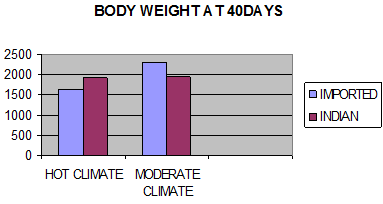
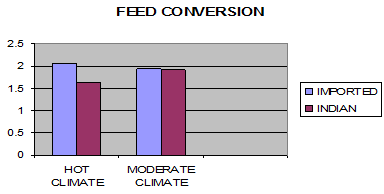
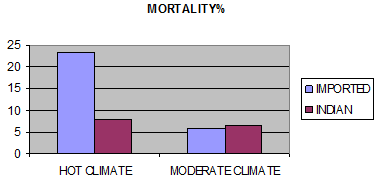
Both Indian and Imported birds were tested under two feed regimens. One is high energy feed processed in to Crumps & Pellets, fed in 3 phase feeding (pre starter for 10 days, starter for 10 days followed by finisher). The second is ordinary mash feed, fed as starter mash up to 23 days and finisher mash after words. Both birds took 5days extra to gain reasonable market weight with mash. But the results in terms of average bodyweight, Feed conversion and mortality were distinctly in favor of Indian bred birds.
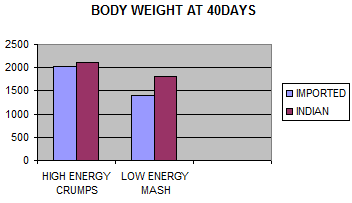
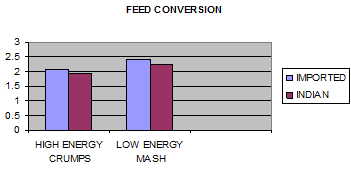
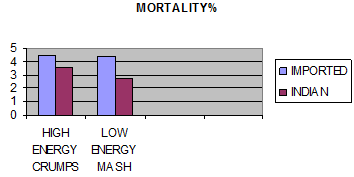
Exposure to low level infection of Micoplasma and Coliforms
Indian bred and Imported birds were compared in a mixed rearing trial. Both the chicks were reared in the same poultry house after thorough cleaning and decontamination. Lab tests showed that the Indian bred chicks were positive for Mycoplasma and nonspecific Coliform infections, which were not known to be dangerous for poultry. The imported birds were MG negative and were free from Coliform bacteria when started. The initial mortality of the Indian chicks was higher. But the later mortality of imported birds was very high leading to poorer performance in the end.
| Description | IMPORTED | INDIAN |
|---|---|---|
| MG STATUS | NEGATIVE | POSITIVE |
| COLIFIRMS | NEGATIVE | POSITIVE |
| 35 DAYS WEIGHT | 1308 gms | 1536 gms |
| FEED CONVERSION | 2.20 | 1.90 |
| 1ST WEEK MORTALITY | 0.6% | 2.23% |
| 35 DAYS MORTALITY | 5.10% | 4.0% |
Conclusion
Poultry breeding for efficiency alone may not continue. The investment on poultry housing and infrastructure is going up. Feed ingredients of good quality are getting expensive and may not be available. Change in environmental requirements will mean exposure of birds to low level of common infections with out treatment, with which the bird has to put up. The birds should perform well in low investment houses, with lower quality feed and withstand some amount of infections with out using high order medicaments. The more practical way is to breed the birds under similar conditions. The initial data shows that the “Adaptability” can be built up in the flock as a genetic trait. The birds bred under suboptimal conditions are performing even better, when better environment is given. The inputs like manpower and investments are also favorable to do this. The growing markets will accept such birds more favorably.
July 2012








